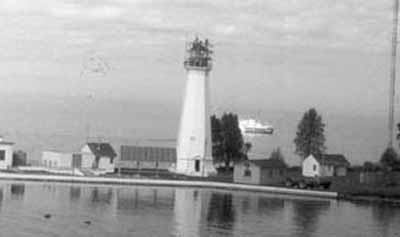Lighthouse
Recognized Federal Heritage Building
St. Lawrence Islands National Park of Canada, Ontario

General view of the place
(© Canadian Coast Guard / Garde côtière canadienne, 1986.)
Address :
Main Duck Island Lightstation, St. Lawrence Islands National Park of Canada, Ontario
Recognition Statute:
Treasury Board Policy on Management of Real Property
Designation Date:
1989-08-24
Dates:
-
1914 to 1914
(Construction)
Event, Person, Organization:
-
Marine Department
(Architect)
Other Name(s):
-
Main Duck Island Lighthouse
(Other Name)
-
Lighttower
(Other Name)
Custodian:
Fisheries and Oceans Canada
FHBRO Report Reference:
88-105
DFRP Number:
56060 00
Description of Historic Place
The Lighthouse on Main Duck Island is a tall, octagonal structure situated at the western tip of Main Duck Island, nine miles out from Long Point on the approach to Kingston Harbor. A classically arranged base, tapered shaft and capital distinguish the reinforced concrete structure. A metal lantern surmounts its flared top. The designation is confined to the footprint of the building.
Heritage Value
The Lighthouse is a Recognized Federal Heritage Building because of its historical associations, and its architectural and environmental values.
Historical Value:
The Lighthouse is closely associated with the provision of navigational aids for marine traffic on the approaches to the St. Lawrence River system and the entrance to Kingston Harbour. The present tower joined an existing trio of lighthouses that constituted the key navigational aids in this treacherous section of Lake Ontario.
Architectural Value:
The Lighthouse is valued for its very good aesthetic design. The structure’s tri-partite division into base, shaft and capital indicates classical influence as do the pediments that surround the entranceways. Very good functional design and high quality materials are evidenced in the use of reinforced concrete. The design which contains no buttresses, signalled a new assurance in the use of reinforced concrete.
Environmental Value:
The Lighthouse reinforces the picturesque maritime character of Main Duck Island and reinforces the approach to the St. Lawrence River system as an important region for shipping. The Lighthouse is well known to the shipping community and is a regional landmark.
Sources:
Main Duck Island Lightstation, Main Duck Island, Lake Ontario, Ontario, Federal Heritage Buildings Review Office Report 88-105; Main Duck Island Lighthouse, Main Duck Island, Lake Ontario, Ontario, Heritage Character Statement 88-105.
Character-Defining Elements
The character-defining elements of Main Duck Island Lighthouse should be respected.
Its very good aesthetics, classical influences and functional design, very good quality materials and craftsmanship, for example: the building’s octagonal form and massing, tall profile and flared platform surmounted by an iron lantern; the classical, tripartite arrangement approximating the form of a classical column with base, tapered shaft and capital and detailing which includes banding around the bottom, the belt course running through the upper portion of the pediment, and the upper course encircling the capital; the two banks of windows with pediment-shaped lintels on either side of the tower; the fine, reinforced concrete construction; the white-painted exterior and the red-painted lantern.
The manner in which the Lighthouse reinforces the picturesque, maritime setting with pastoral backdrop on Main Duck Island, and acts as a regional landmark as evidenced by: the structure’s very good aesthetics and location on a narrow spit of flat land at the western extremity of Duck Island, which compliment it’s setting; the Lighthouse’s high visibility which make it a make it familiar landmark to the shipping community.
Heritage Character Statement
Disclaimer -
The heritage character statement was developed by FHBRO to explain the reasons for the designation of a federal heritage building and what it is about the building that makes it significant (the heritage character). It is a key reference document for anyone involved in planning interventions to federal heritage buildings and is used by FHBRO in their review of interventions.
The Main Duck Island Lighthouse, which is 80 feet high, was erected in 1914 by the Department of Marine and Fisheries. The building is owned by Transport Canada and is administered by the Canadian Coast Guard. See FHBRO Building Report No. 88-105.
Reason for Designation
The Main Duck Island lighthouse was designated "Recognized" because of the key role it played in ensuring safe navigation in Lake Ontario, the elegance of its architecture and the effectiveness of its functional design, closely tied to its primary material, reinforced concrete.
The lighthouse built on Main Duck Island joined an existing trio of lighthouses which constituted the key navigational aids in this treacherous section of Lake Ontario. The architecture of this lighthouse is skillfully proportioned through the use of classical references and, unlike the first experiments with reinforced concrete for lighthouse construction in Canada, its design contains no buttresses, signalling a new assurance in the use of reinforced concrete.
Character Defining Elements
The heritage character of this octagonal lighthouse derives primarily from its configuration. Its long tapered profile consists of a base, shaft and capital. This aspect, as well as other details, such as the pediments surmounting the entranceways and the tri-partite division of the column, are classical features that should be preserved.
Over the years, the lighthouse has required relatively little maintenance, which suggests high quality execution, durable materials and a sound design. If repairs are needed, the original forms and materials should be respected. Reinstatement of the lower windows which are presently blocked would enhance the aesthetic qualities of the original 1914 design.
This lighthouse, with its lofty stature set in a pastoral setting, defines the panoramic character of the western tip of Main Duck Island. It would be desirable to leave this setting, which exemplifies the historical theme mentioned above, unchanged.